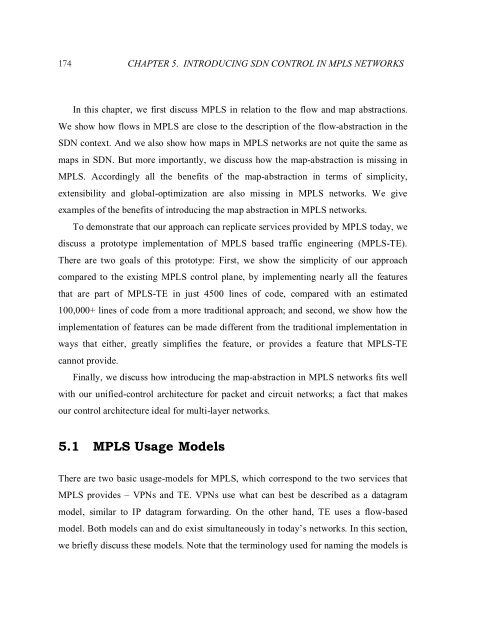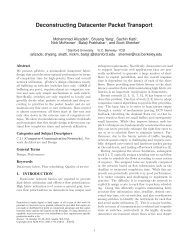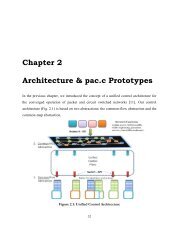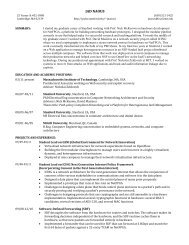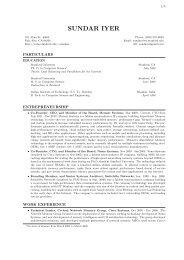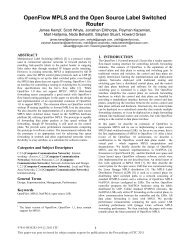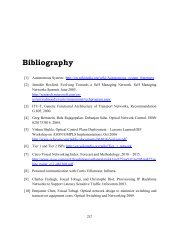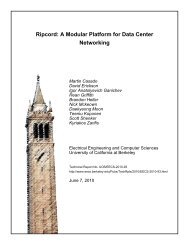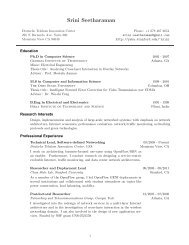Chapter 5 Introducing SDN Control in MPLS Networks - High ...
Chapter 5 Introducing SDN Control in MPLS Networks - High ...
Chapter 5 Introducing SDN Control in MPLS Networks - High ...
You also want an ePaper? Increase the reach of your titles
YUMPU automatically turns print PDFs into web optimized ePapers that Google loves.
174 CHAPTER 5. INTRODUCING <strong>SDN</strong> CONTROL IN <strong>MPLS</strong> NETWORKSIn this chapter, we first discuss <strong>MPLS</strong> <strong>in</strong> relation to the flow and map abstractions.We show how flows <strong>in</strong> <strong>MPLS</strong> are close to the description of the flow-abstraction <strong>in</strong> the<strong>SDN</strong> context. And we also show how maps <strong>in</strong> <strong>MPLS</strong> networks are not quite the same asmaps <strong>in</strong> <strong>SDN</strong>. But more importantly, we discuss how the map-abstraction is miss<strong>in</strong>g <strong>in</strong><strong>MPLS</strong>. Accord<strong>in</strong>gly all the benefits of the map-abstraction <strong>in</strong> terms of simplicity,extensibility and global-optimization are also miss<strong>in</strong>g <strong>in</strong> <strong>MPLS</strong> networks. We giveexamples of the benefits of <strong>in</strong>troduc<strong>in</strong>g the map abstraction <strong>in</strong> <strong>MPLS</strong> networks.To demonstrate that our approach can replicate services provided by <strong>MPLS</strong> today, wediscuss a prototype implementation of <strong>MPLS</strong> based traffic eng<strong>in</strong>eer<strong>in</strong>g (<strong>MPLS</strong>-TE).There are two goals of this prototype: First, we show the simplicity of our approachcompared to the exist<strong>in</strong>g <strong>MPLS</strong> control plane, by implement<strong>in</strong>g nearly all the featuresthat are part of <strong>MPLS</strong>-TE <strong>in</strong> just 4500 l<strong>in</strong>es of code, compared with an estimated100,000+ l<strong>in</strong>es of code from a more traditional approach; and second, we show how theimplementation of features can be made different from the traditional implementation <strong>in</strong>ways that either, greatly simplifies the feature, or provides a feature that <strong>MPLS</strong>-TEcannot provide.F<strong>in</strong>ally, we discuss how <strong>in</strong>troduc<strong>in</strong>g the map-abstraction <strong>in</strong> <strong>MPLS</strong> networks fits wellwith our unified-control architecture for packet and circuit networks; a fact that makesour control architecture ideal for multi-layer networks.5.1 <strong>MPLS</strong> Usage ModelsThere are two basic usage-models for <strong>MPLS</strong>, which correspond to the two services that<strong>MPLS</strong> provides – VPNs and TE. VPNs use what can best be described as a datagrammodel, similar to IP datagram forward<strong>in</strong>g. On the other hand, TE uses a flow-basedmodel. Both models can and do exist simultaneously <strong>in</strong> today’s networks. In this section,we briefly discuss these models. Note that the term<strong>in</strong>ology used for nam<strong>in</strong>g the models is


